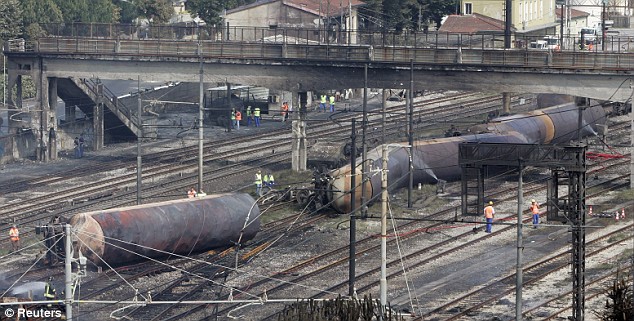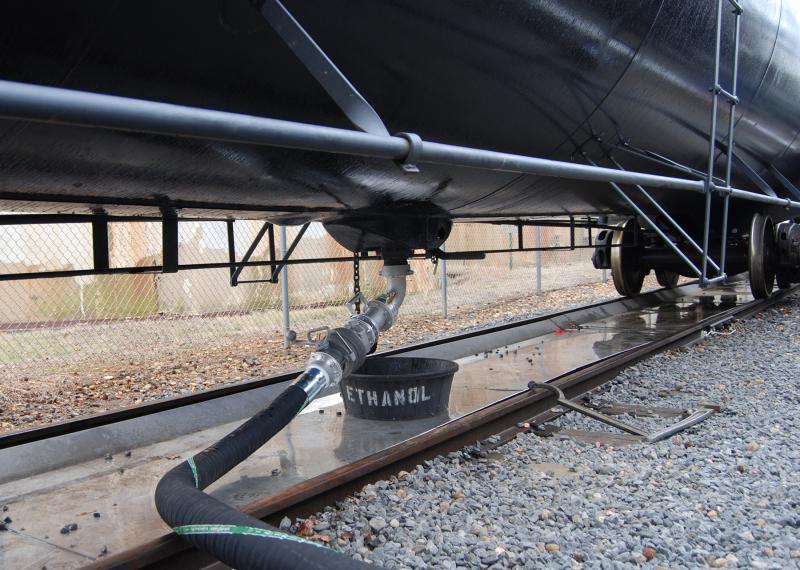Some people may think that trains are troublesome because of the inconvenience it brings when the railroad crossing gates come down. But no one can deny the fact that a railcar is still a reliable and efficient means of transportation when moving heavy and bulky freight over long distances. Although a railcar is already considered safe for you and your goods, have you ever thought about how railcar GPS tracking further enhances railcar security for the goods people love? This technology greatly helps in ensuring that the goods arrive at their destination on time and safely.
Rail systems throughout the world use GPS to track the movement of locomotives, rail cars, maintenance vehicles, and wayside equipment in real time. The technology helps reduce accidents, delays, and operating costs, while increasing track capacity, customer satisfaction, and cost effectiveness.
Railcar Disasters
Various railway disasters have occurred over the years, convincing lawmaking bodies to tighten up security measures and enhance tracking systems.
Lac-Mégantic rail disaster
On July 6, 2013, 47 people died in the small eastern Quebec town in a major derailment. An unattended runaway train carrying 7.7 m liters of petroleum crude oil barreled into Lac-Megantic at 65 mph (104 km/h) and jumped the tracks near the center of town. The train slammed to a stop and erupted in flames. This explosion burned most of the lakeside town’s downtown center. Children were orphaned, over 2,000 people evacuated, and dozens of homes were destroyed. Over 40 buildings were razed, including the public library, and millions of liters of oil seeped into the soil and the nearby river.
Scroll down for the videos

Reuters
Viareggio freight train accident
Shortly after midnight, a gas-laden freight train, filled with butane and propane, derailed and plowed through the small Italian town of Viareggio, causing an explosion and a fire that killed 12 people and injured 50. The explosion collapsed five buildings, crumbled homes, consumed cars, and killed residents in their sleep. Three children had been pulled alive from the rubble of their collapsed home shortly before daybreak. About 1,000 people had been evacuated from their homes as a precaution. The train’s two engineers were only lightly injured. While being questioned in the hospital, they said they had felt an impact some 200 meters outside the station, shortly before the rear of the train flew off the tracks. The derailment may have been caused by damage to the tracks or by a problem with the train’s braking system.
Chatsworth Metrolink collision
The train driver blamed for the worst US train crash to date was sending and receiving text messages seconds before his passenger-filled train skipped a red light and collided head-on with a freight train. The Metrolink commuter train crashed into a Union Pacific freight locomotive on September 12 in Chatsworth, California, killing 25 people and injuring 135. The operator, identified as Robert Martin Sanchez, 46, was killed in the crash. Local TV station KCBS reported that a teenager claimed to have received a text message from the Metrolink engineer a minute before the collision. Following the accident, California authorities temporarily banned railroad workers from using cellphones on duty.
The Advantages of Using Railcar GPS Tracking
Increases visibility
Railcar GPS tracking, first and foremost, can help increase visibility. Railcar location and movement updates are available in real time and can be viewed through a live map tracking system. This enables companies to easily track drivers, vehicle location, delivery status, and inventory items.
With the help of railcar GPS tracking technology, employees are able to successfully prevent losses and ensure safe storage of goods, as well as efficiently locate missing items. Once goods are delivered or have arrived to a certain place, the manager is notified by a push message. Being able to monitor products throughout will increase security and boost the quality of the products. Overall, this helps managers ensure timely deliveries, minimize theft, and have an overall view of the operation to help in decision-making.
Monitors speed and driver behavior
Railcar information such as location, speed, acceleration, brakes, RPM, fuel efficiency, and engine data are among the vital information that GPS trackers gather and analyze. Its live tracking system allows you to receive this data automatically once the predefined limits are breached. Tracking this data is necessary to avoid unnecessary wear and tear and railcar disasters due to driving habits. Suitable GPS tracking devices like Trackimo enable you to monitor all these.

Advantech B+B SmartWorx
Monitors inventory
GPS trackers monitor not only trains but its cargoes too. It’s a big help in shipment monitoring and inventory by keeping a list and organizing the different types of cargo into the correct car. With railcar GPS tracking, losing or having items stolen can be avoided. Once delivered, time of arrival is automatically recorded into the system and can be seen by authorized remote users.
Predicts maintenance
Predictive maintenance in railcar GPS tracking allows logistics organizations to monitor railcars and predict quality issues and upcoming maintenance, and conduct necessary repairs on schedule to help minimize disruptions to normal operations—instead of forcing companies and clients to react to sudden, unexpected breakdowns. By providing insights into when and where parts are needed, railcar GPS tracking greatly helps reduce expensive, rushed shipping costs for spares, making it easier to save money.
Predictive maintenance can also reduce overtime expenses by providing precise predictions of probable upcoming issues by scheduling the accurately skilled personnel. By lessening time-consuming maintenance, predictive maintenance systems increase fleet availability.
Monitors condition of cargo
Some factories regularly receive shipments of perishable or sensitive goods that only stay fresh for a short time, and/or require specific environmental conditions to maintain quality. Using specialized GPS trackers, you can now equip a crate of eggs or a barrel of milk and monitor the humidity in the storage area, the temperature of the goods, and the shock and vibration levels these items experience during shipment. With immediate insight into potential damage, you can fix a temperature setting, send a replacement shipment, or warn your customer right away. In addition, you can identify exactly when and where the damage occurred, and adjust your route accordingly for future shipments. You can use this information to notify truck drivers and clients of damaged shipments long before they arrive at your factory and to get a new shipment on its way.

Dixon Valve
Reduces fuel consumption
Recent studies indicate that transport industries have reported the significant reduction in fuel usage as the biggest advantage of GPS tracking. The use of a railcar GPS tracking system mainly gives better route options for locomotive drivers. Choosing which routes to take makes locomotive driving more efficient, saving companies time and money. In doing so, railcars with GPS tracking can eliminate unnecessary costs and reduce unproductive work. This reduces the time a driver has to spend on the road, resulting in faster delivery arrivals and lesser fuel expenses.
Detects theft
Right now, one of the biggest areas of interest from top companies in various industries is reducing theft of property or products. With railcar GPS tracking, the railways industry can implement preventative measures, reducing theft of goods and property for a minimal investment. The geofence feature in GPS trackers detects theft by immediately notifying you when the cargo equipped with the device is taken outside a predefined safe zone or beyond business hours, thereby improving the security of goods. Moreover, railcar GPS tracking can alert operators whenever a train enters or leaves the rail yards.
Railcar GPS tracking systems can be designed to alert you when tampering occurs, and the system as a whole can be architectured to maintain security even if a specific device has been compromised.
Prevents disasters
After the 2008 Metrolink disaster, which killed 25 passengers and injured 135, US congress implemented a bill to enhance GPS tracking systems aboard trains. Designed to meet the Rail Safety Improvement Act of 2008, various GPS companies have enhanced existing GPS tracking technology to provide precision train control (PTC) systems, which was mandated by the US government. Current GPS tracking devices transmit signals from up to four GPS satellites to a receiver. The PTC program works by the train receiving information about its location and along which railway lines it can safely travel, known by the industry term movement authorities. Onboard computers receive the GPS data and can control the movement of the train automatically, preventing any movement that is unsafe according to up-to-date travel information.
Improves relationships with clients
A bad habit that most businesses do is attracting new customers all the while neglecting the old ones. This more often than not results in a lack of growth in clientele. With railcar GPS tracking, companies can prioritize both new and old customers. Railcars can deliver goods on time more often, relay timely reports of the condition of goods, help clients prevent damages, ensures that you would be able to respond to customers in case of delay, calculate the estimated time of delivery for them, and therefore maintain healthy business relationships with them through the help of GPS technology. Railcar GPS tracking, hence, increases employee productivity and positive feedback.
Conclusion
Without a doubt, GPS tracking makes jobs easier for conductors and operators. If private companies want to take part of the billion-dollar railcar industry, railcar GPS tracking is the way to go. Currently, researchers are exploring ways to integrate GPS into vehicle-to-vehicle communication systems that could warn trains and cars of potential collisions at railroad crossings.
Watch the videos below